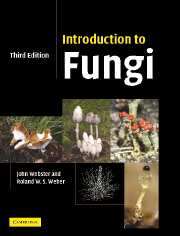Book contents
- Frontmatter
- Contents
- Preface to the first edition
- Preface to the second edition
- Preface to the third edition
- Acknowledgements
- 1 Introduction
- 2 Protozoa: Myxomycota (slime moulds)
- 3 Protozoa: Plasmodiophoromycota
- 4 Straminipila: minor fungal phyla
- 5 Straminipila: Oomycota
- 6 Chytridiomycota
- 7 Zygomycota
- 8 Ascomycota (ascomycetes)
- 9 Archiascomycetes
- 10 Hemiascomycetes
- 11 Plectomycetes
- 12 Hymenoascomycetes: Pyrenomycetes
- 13 Hymenoascomycetes: Erysiphales
- 14 Hymenoascomycetes: Pezizales (operculate discomycetes)
- 15 Hymenoascomycetes: Helotiales (inoperculate discomycetes)
- 16 Lichenized fungi (chiefly Hymenoascomycetes: Lecanorales)
- 17 Loculoascomycetes
- 18 Basidiomycota
- 19 Homobasidiomycetes
- 20 Homobasidiomycetes: gasteromycetes
- 21 Heterobasidiomycetes
- 22 Urediniomycetes: Uredinales (rust fungi)
- 23 Ustilaginomycetes: smut fungi and their allies
- 24 Basidiomycete yeasts
- 25 Anamorphic fungi (nematophagous and aquatic forms)
- References
- Index
- Plate section
5 - Straminipila: Oomycota
- Frontmatter
- Contents
- Preface to the first edition
- Preface to the second edition
- Preface to the third edition
- Acknowledgements
- 1 Introduction
- 2 Protozoa: Myxomycota (slime moulds)
- 3 Protozoa: Plasmodiophoromycota
- 4 Straminipila: minor fungal phyla
- 5 Straminipila: Oomycota
- 6 Chytridiomycota
- 7 Zygomycota
- 8 Ascomycota (ascomycetes)
- 9 Archiascomycetes
- 10 Hemiascomycetes
- 11 Plectomycetes
- 12 Hymenoascomycetes: Pyrenomycetes
- 13 Hymenoascomycetes: Erysiphales
- 14 Hymenoascomycetes: Pezizales (operculate discomycetes)
- 15 Hymenoascomycetes: Helotiales (inoperculate discomycetes)
- 16 Lichenized fungi (chiefly Hymenoascomycetes: Lecanorales)
- 17 Loculoascomycetes
- 18 Basidiomycota
- 19 Homobasidiomycetes
- 20 Homobasidiomycetes: gasteromycetes
- 21 Heterobasidiomycetes
- 22 Urediniomycetes: Uredinales (rust fungi)
- 23 Ustilaginomycetes: smut fungi and their allies
- 24 Basidiomycete yeasts
- 25 Anamorphic fungi (nematophagous and aquatic forms)
- References
- Index
- Plate section
Summary
Introduction
The phylum Oomycota, alternatively called Peronosporomycetes (Dick, 2001a), currently comprises some 800–1000 species (Kirk et al., 2001). The Oomycota as a whole have been resolved as a monophyletic group within the kingdom Straminipila in recent phylogenetic studies (e.g. Riethmüller et al., 1999; Hudspeth et al., 2000; see Fig. 4.2), although considerable rearrangements are still being performed at the level of orders and families. A scholarly treatment of the Oomycota has been published by Dick (2001a) and will remain the reference work for many years to come. Because of the outstanding significance of Oomycota, especially in plant pathology, we give an extended treatment of this group.
The vegetative hypha
Although some members of the Oomycota grow as sac-like or branched thalli, most of them produce hyphae forming a mycelium. Oomycota are now known to be the result of convergent evolution with the true fungi (Eumycota), and their hyphae differ in certain details. However, the overall functional similarities are so great that they provide a persuasive argument for the fundamental importance of the hypha in the lifestyle of fungi (Barr, 1992; Carlile, 1995; Bartnicki-Garcia, 1996). Much physiological work has been carried out on hyphae of Oomycota (see Chapter 1), and the results have a direct bearing on our understanding of the biology of the Eumycota. Like them, the hyphae of Oomycota display apical growth and enzyme secretion, ramify throughout the substratum by branching to form a mycelium, and can show morphogenetic plasticity by differentiation into specialized structures such as appressoria or haustoria.
- Type
- Chapter
- Information
- Introduction to Fungi , pp. 75 - 126Publisher: Cambridge University PressPrint publication year: 2007
- 1
- Cited by

